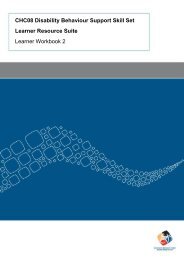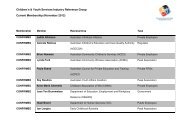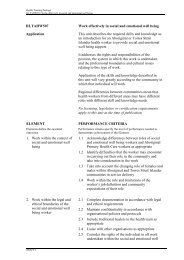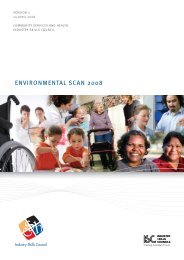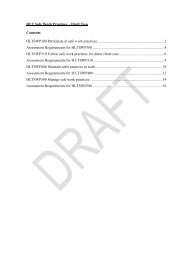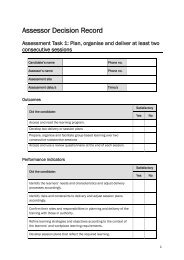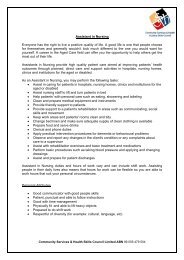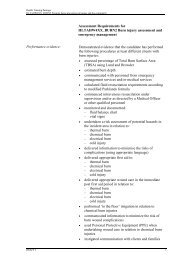2013 Environmental Scan - Community Services & Health Industry ...
2013 Environmental Scan - Community Services & Health Industry ...
2013 Environmental Scan - Community Services & Health Industry ...
Create successful ePaper yourself
Turn your PDF publications into a flip-book with our unique Google optimized e-Paper software.
KEY INSIGHTS<br />
KEY WORKFORCE<br />
CHALLENGES<br />
In <strong>2013</strong>, the health and community<br />
services workforce will need to respond to<br />
three significant challenges:<br />
1. High demand for care from the<br />
community, driven by growing<br />
expectations, increasing comorbidity,<br />
the contribution of technology and<br />
an ageing population (AIHW 2012b;<br />
ACOSS 2012).<br />
2. Ambitious government reforms to move<br />
the industry towards a client-led model<br />
of funding and care, beginning with the<br />
Aged Care Reform Package (DoHA<br />
2012a) and the National Disability<br />
Insurance Scheme (COAG 2012a).<br />
3. Reduced growth in expenditure by<br />
Australian and State governments<br />
(DoHA 2012; FaHCSIA 2012).<br />
KEY INDUSTRY<br />
PRIORITIES<br />
The following industry challenges and skills<br />
have been identified in this <strong>Environmental</strong><br />
<strong>Scan</strong> (E<strong>Scan</strong>) as the top priorities for the<br />
<strong>Community</strong> <strong>Services</strong> and <strong>Health</strong> industry<br />
in <strong>2013</strong> and over the next five years:<br />
ww<br />
Workers and managers within the<br />
industry need to develop new skills<br />
to adapt to the client-led model of<br />
care, particularly within autonomous<br />
care environments. Critical skills<br />
that training packages will need<br />
to incorporate include:<br />
––<br />
Service coordination<br />
––<br />
Financial management<br />
––<br />
Goal-based planning (KPMG 2012;<br />
Chenoweth and Clements 2009).<br />
ww<br />
More sustainable workforce development<br />
models that make more efficient use of<br />
Higher Education (HE) and Vocational<br />
Education and Training (VET) based<br />
roles, and which provide more fluid<br />
pathways for workers to move between<br />
sectors and from VET-based to higher<br />
education-based roles and vice versa<br />
ww<br />
Creating a common pathway of<br />
competencies, so that workers at all<br />
levels and across the industry (but<br />
particularly in aligned sectors, for<br />
example mental health, aged care<br />
and disability services) can respond<br />
appropriately to comorbidity and<br />
complex care needs (DoHA 2012a;<br />
NMHCCF 2012). Common pathways,<br />
which have the potential to increase the<br />
retention of skilled workers, may assist<br />
career planning and development with<br />
the industry, provided cultural issues<br />
and hierarchies, are considered<br />
ww<br />
Improving and supporting management<br />
and leadership capacity in a rapidly<br />
changing workforce development<br />
environment. This will create the drive<br />
for future workforce development and<br />
job redesign.<br />
BROADER INDUSTRY<br />
TRENDS<br />
The introduction of a demand-led system<br />
has the potential to increase the supply<br />
of VET-trained workers in health and<br />
community services. However, there are<br />
concerns within industry about the quality<br />
and regulation of training in a demandled<br />
system. The <strong>Community</strong> <strong>Services</strong> &<br />
<strong>Health</strong> <strong>Industry</strong> Skills Council (CS&HISC)<br />
also awaits the implementation of further<br />
planned reforms, that enable reporting<br />
on the total VET activity in Australia not<br />
only delivery through Government-funded<br />
institutions and places. Reporting of this<br />
data will improve assessment of the impact<br />
of CS&HISC Training Packages.<br />
Responding to the industry’s skills needs<br />
in a timely manner will require adaptations<br />
to the existing Training Packages, and an<br />
improvement in ‘speed to market’, with<br />
a greater emphasis and sophistication<br />
in workforce development – evaluation<br />
of successful approaches – coordinated<br />
planning and strategy – adoption of a<br />
systems approach. Action will need to be<br />
oriented around the following approaches:<br />
The priority areas for CS&HISC in <strong>2013</strong><br />
have been reinforced by the Standing<br />
Council on Tertiary Education Skills<br />
& Employment (SCOTESE) and its<br />
endorsement of the new Training Package<br />
standards and its reaffirmation of VET<br />
as competency based and not capability<br />
based tertiary education.<br />
CS&HISC will be driving discussion and<br />
action on increasing the ‘speed to market’<br />
for Training Package revisions to meet<br />
the increasing demand for new skills,<br />
qualifications and roles; and monitoring<br />
the quality assurance regime (particularly<br />
ensuring workplace content and the<br />
regulation of assessment). This latter<br />
priority is also driven by jurisdictions<br />
moving to a demand-led system for VET.<br />
The <strong>2013</strong> E<strong>Scan</strong> findings build on themes<br />
identified in previous E<strong>Scan</strong>s, such as<br />
the growing emphasis on primary health,<br />
person-centred service work models<br />
and the need for greater investment in<br />
workforce planning and development.<br />
The issues identified in this E<strong>Scan</strong> have<br />
significant implications for the <strong>Community</strong><br />
<strong>Services</strong> and <strong>Health</strong> industry.<br />
As the major industry body,<br />
we will continue to consult<br />
and engage with industry<br />
stakeholders and policy<br />
makers to ensure that<br />
Australia has the workforce<br />
it deserves, to best meet<br />
the challenges of a growing<br />
population which demand<br />
affordable, accessible high<br />
quality care<br />
THE CARE INDUSTRY – A TIME FOR ACTION<br />
The introduction of a demand-led system has the potential<br />
to increase the supply of VET-trained workers in <strong>Community</strong><br />
<strong>Services</strong> and <strong>Health</strong><br />
ww<br />
In the short term, further action to<br />
support industry provided clinical and<br />
work placements for VET students.<br />
This is already an under-funded and<br />
under-supported activity and the<br />
transition to demand-led funding<br />
for VET students has the potential<br />
to overwhelm existing capacity<br />
ww<br />
Over the medium term, more<br />
sustainable models of quality care are<br />
required that alleviate the pressure<br />
on professional roles, particularly<br />
Registered Nurses, giving greater<br />
prominence to existing and new<br />
VET-based roles.<br />
CS&HISC is the recognised national<br />
advisory body on skills and workforce<br />
development.<br />
As the major industry body, we will<br />
continue to consult and engage with<br />
industry stakeholders and policy makers<br />
to ensure that Australia has the workforce<br />
it deserves, to best meet the challenges<br />
of a growing population which demand<br />
affordable, accessible high quality care.<br />
ENVIRONMENTAL SCAN <strong>2013</strong> : KEY INSIGHTS<br />
6 7





